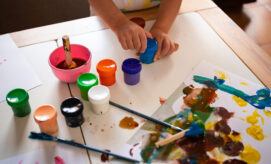The relationships that a young child forms with adult caregivers become the foundation for that child’s future development. When children form a secure attachment with an adult caregiver who helps them feel safe and cared for, they can learn, grow, and explore with confidence.
Relationships that foster secure attachment begin as early as birth, and continue to have a positive impact through later childhood, and even into adulthood. In this article, we explore the meaning of attachment and the crucial role it plays in healthy development. We also highlight ways in which you can nurture secure attachments with the little ones in your care.
Understanding Attachment
Attachment refers to a very specific kind of relationship between infants and their care providers. An article by Abi M. B. Davis, a PhD researcher at University of Lincoln and Katherine B. Carnelley, associate professor at the University of Southampton defines attachment as: “…a close bond between two people. Usually, the first attachment that we experience is an attachment to a parent when we are babies (often, though not always, to mothers at first). This person means safety and security for infants, who look to their caregiver for protection, comfort, and emotional support. Young children usually get very upset when they are apart from their first caregiver. When children get older, they begin to form attachments with other people, like grandparents or other caregivers.”
Attachment forms throughout a child’s early years, but attachment relationships are particularly crucial between birth and two years of age, when children are completely dependent on their caregivers to get their needs met. The responsiveness, affection, and nurturance that caregivers provide during these earliest years provides children a sense of security that will equip them to form other healthy relationships as they get older.
How Attachment is Developed
Attachment is formed through early interactions between infants and their caregivers. Back-and-forth exchanges between a child and engaged adult creates a connection that helps the child feel supported. By responding to a child’s cues, such as picking the child up when they cry or offering a bottle when they seem hungry, caregivers demonstrate that they are attuned to the child’s needs, and that the child can feel safe and secure.
An article by Marriage and Family Therapist, Andrea Haffner, explains that a sense of security is communicated to infants in a variety of ways: “During infancy, attachment grows through eye contact, through touch and closeness, through hearing and mirroring one another…Through this developing attunement a baby comes to feel that her needs will be largely understood and met. She thus feels a sense of security and trust in her caregivers, one that gradually extends to a sense of security in herself and trust in her world.”
4 Attachment Styles
First 5 California, a statewide organization that helps ensure a strong start in life for California children, describes the 4 styles of attachment:
- Secure attachment: Children with this attachment style feel safe and secure in their relationships and are able to explore their environment without fear of abandonment. They are confident and have a positive view of themselves. As caregivers, we strive to help children develop a secure attachment style!
- Anxious-ambivalent attachment: Children with this attachment style can appear fearful and might cling to their caregivers or have difficulty exploring their environment during play. They might need to be reassured that they are safe and cared for.
- Anxious-avoidant attachment: Children with this attachment style often avoid their caregivers and may have difficulty forming close, trusting relationships. While playing, you might observe them playing by themselves, and showing little interest in playing with other children.
- Disorganized attachment: Children with this attachment style may have trouble understanding and managing their emotions. During play, they may appear confused or overwhelmed. They often go to their caregiver for comfort but then push the caregiver away when they try to offer support.
Caregiver Relationships and Secure Attachment
Engaged, nurturing relationships with caregivers help a child develop a sense of trust in the people around them and a foundation for ongoing healthy social development. An article and chart posted on the Illinois Early Learning website shows the connection between attachment relationships and early developmental milestones:
“Secure attachment relationships are the foundation for healthy social and emotional development. Children create special bonds with one or a few adults who are warm, sensitive, responsive, and dependable in meeting their needs. These relationships help children gain trust, confidence, and security, all important in order for children to explore, learn, interact, and build relationships with others.
Attachment relationships first consist of meeting children’s basic needs through sensitive caregiving and synchrony. If these needs are consistently met, trust develops. Once children begin to crawl and walk, they use their attachment figures as a secure base for exploration.”
Attachment to Multiple Care Providers
While attachment is often thought of as referring to parent-child relationships, a study published in the Journal of Applied Developmental Psychology found that children as young as infants have the ability to form attachments with multiple caregivers. The journal article reported that “existing studies suggest that infants’ relationships with early childhood program teachers or caregivers may provide important contributions to young children’s development…Moreover, there is at least preliminary evidence that attachment with child care providers can influence child outcomes independently of attachment with parents.”
This demonstrates that the relationships that we form with the young children in our care can have a significant impact on their social development and wellbeing. It is a reminder of the important work that you do to develop meaningful relationships with the little ones in your care everyday!
Nurturing Secure Attachment in Early Learning Settings
Creating an environment in which children can develop healthy attachment is something that many care providers do naturally. Below are key considerations for applying an attachment-focused caregiving lens to create strong, meaningful bonds with the infants and young children in your care.
Respond to Children’s Cues
When infants and toddlers cry out or ask for help, respond to them with warmth and affection. Help them to soothe when they are crying and offer them a bottle when they seem hungry. When their needs are responded to, young children feel safe, and they learn that they can rely on others to care for them when they are in need. This ability to trust creates a foundation for the continued development of healthy relationships as the child gets older.
Facilitate Meaningful Interactions
The everyday interactions we enjoy with the children in our care create opportunities to form trusting relationships and engage in meaningful exchanges. With infants, these exchanges occur most often during daily care routines like mealtimes, diaper changes, and tummy time. Long before infants say their first word, we can engage them through eye contact, smiles, cooing, laughter, gestures, and singing. These connections create a sense of safety and secure attachment.





